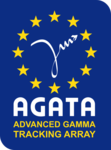
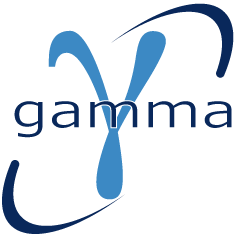

Index
- Introduction
- AGATA at LNL
- AGATA pictures
- AGATA video
- AGATA experiments
- GALILEO
- Previous Arrays
- PRISMA
- PLUNGER
- EUCLIDES
- SPIDER
- SAURON
- DANTE
- TRACE
- OSCAR
- LaBr3
- NEDA
- NEUTRON WALL
- RFD
- CTADIR
- AGATA Publications
- GALILEO Publications
- Technical Publications
- Open projects
- Defended thesis
- Visiting LNL
- People
- Useful links
- PISOLO
Introduction
The Gamma Spectroscopy group performs nuclear structure studies using stable beams provided by the TANDEM-ALPI-PIAVE (TAP) accelerators of Legnaro National Laboratory, and high-resolution Ge arrays coupled to different ancillary detectors. The group works in close collaboration with the “Galileo Galilei” physics department of the University of Padova and INFN-Padova. Furthermore, the group belongs to the GAMMA collaboration for nuclear physics. This collaboration is part of the INFN – National Scientific Committee 3 (CSN3) initiative, which involves 5 INFN divisions:
- INFN – Laboratori Nazionali di Legnaro (LNL),
- INFN – Sezione di Firenze (FI),
- INFN – Sezione di Milano (MI),
- INFN – Sezione di Padova (PD),
- University of Camerino.
The group is also involved with SPES, which is a next generation ISOL-type accelerator that together with the operation of existing machines, is the future of LNL. SPES will provide Radioactive Ion Beam for nuclear physics and astrophysics research, as well as for interdisciplinary applications.
Currently, the AGATA array is being employed to detect γ radiation emitted after reactions such as fusion-evaporation, and low-energy Coulomb excitation. At the moment, GALILEO, the native array for detection γ-ray radiation, is not operational as all efforts are focused on AGATA.
The physics program of the group is focused, but not limited, on following topics:
- Shell structure in n-rich nuclei
- Isospin symmetries and n-p pairing
- Pigmy resonance of interest in astrophysics
- Structure of nuclei at the proton-drip line
- Critical points and phase transitions between different nuclear shapes
In addition to the local activities, the group also performs research in collaboration with different laboratories such as GANIL, ISOLDE, JYU, the RIKEN Nishina Center, and GSI FAIR
AGATA@LNL
AGATA (Advanced GAmma Tracking Array) is a highly segmented High Purity Germanium (HPGe) detector array. It is a European collaboration project funded by twelve countries in Europe. The project was proposed in 2001 and in 2002 it was signed by the participant countries. AGATA is capable of high counting event rates and can be coupled with ancillary detectors, such as magnetic spectrometers, fast-timing detectors charged particles or neutron detectors. The AGATA detectors are Ge-detectors that are 36-fold segment with six-fold azimuthal and six-fold longitudinal segmentation.
Since 2022, AGATA array is installed in the Legnaro Laboratories, where it is coupled to the magnetic spectrometer PRISMA. AGATA array is complemented by 9 LaBr3 detectors. Detailed description of AGATA setup at LNL, data acquisition system and complementary instrumentation is given in NIM A paper.
Performance figures of AGATA obtained during the 2022 campaign were published in Legnaro Annual Reports here and here. Note that the additional shielding was present in front of AGATA during this evaluation, details are given in the reports.

AGATA Pictures





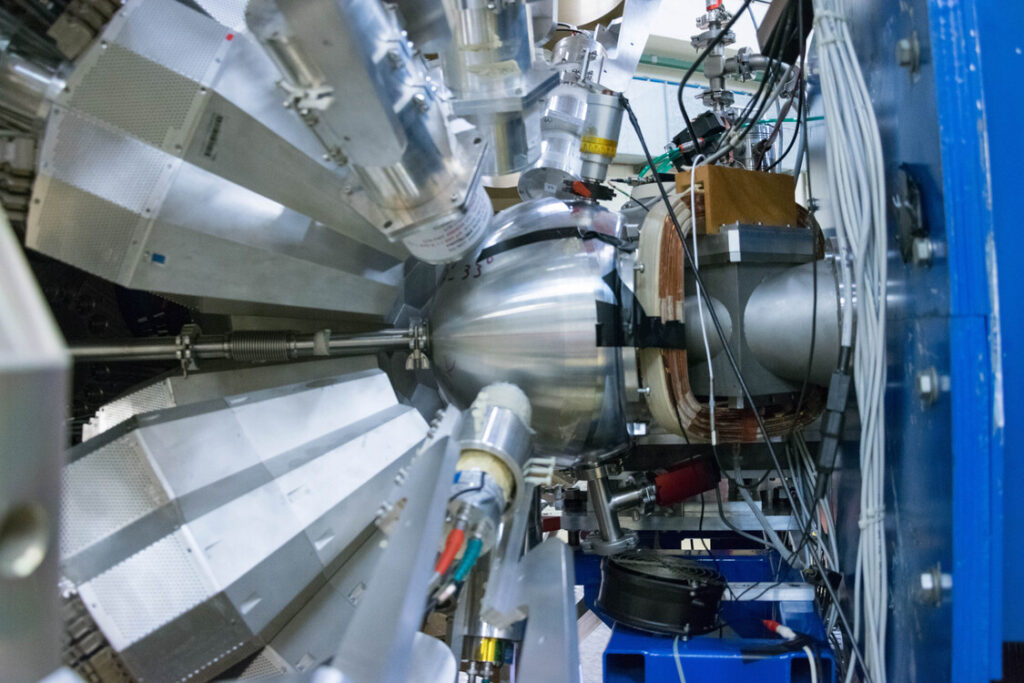
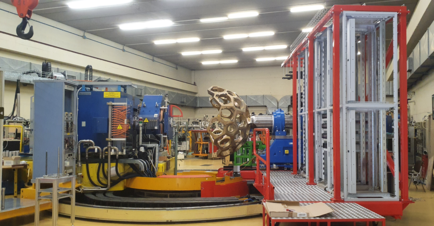
Pictures from the AGATA campaign can be found here, pictures taken by M. Balogh.
Video of AGATA installation at LNL
Experiments performed in 2nd campaign of AGATA@LNL
November 2025 | EXP 052 | proposal no. 25.14 | Spokespersons: N. Marchini | E-Log | TANDEM: 58Ni @183 MeV | AGATA+SPIDER+DANTE
November 2025 | EXP 051 | proposal no. 24.39 | Spokespersons: G. Corbari | E-Log | TANDEM: 6Li @9MeV | AGATA+TRACE+SAURON
October 2025 | EXP 050 | proposal no. 24.44 | Spokespersons: Y. Son | E-Log | TANDEM: 1H @9MeV | AGATA
October 2025 | EXP 049 | proposal no. 24.28 | Spokespersons: C. M. Sullivan | E-Log | TANDEM: 32S @120MeV | AGATA+LaBr3+EUCLIDES
July 2025 | EXP 048 | proposal no. 24.31 | Spokespersons: J. Benito | E-Log | TANDEM: 58Ni @240MeV | AGATA+LaBr3+EUCLIDES+PLUNGER
April 2025 | EXP 047 | proposal no. 24.03 | Spokespersons: C. Fahlander | E-Log | TANDEM: 32S @120MeV | AGATA+LaBr3+SPIDER+DANTE
April 2025 | EXP 046 | proposal no. 24.40 | Spokespersons: S. Pigliapoco, F. Galtarossa | E-Log | TANDEM: 18O @35MeV | AGATA+LaBr3+SPIDER+PLUNGER
March 2025 | EXP 043 | proposal no. 24.30 | Spokespersons: W. Korten, J. Gerl | E-Log | TANDEM: 58Ni @240MeV | AGATA+LaBr3+SPIDER+DANTE
March 2025 | EXP 044 | proposal no. 24.26 | Spokespersons: P.E. Garrett, A. Nannini, M. Zielinska, K. Wrzosek-Lipska | E-Log | TANDEM: 60Ni @187MeV | AGATA+LaBr3+SPIDER
March 2025 | EXP 045 | proposal no. 24.36 | Spokespersons: D. Kalaydjieva, M. Siciliano | E-Log | TANDEM: 58Ni @193MeV | AGATA+LaBr3+SPIDER+DANTE
February 2025 | EXP 042 | proposal no. 24.27 | Spokespersons: D. Stramaccioni, J. J. Valiente | E-Log |TANDEM: 1H @28MeV | AGATA+LaBr3+SAURON
December 2024 | EXP 040 | proposal no. 24.12 | Spokespersons: Son | E-Log | TANDEM: 1H @10MeV | AGATA+Labr3
December 2024 | EXP 041 | proposal no. 24.01 | Spokespersons: Chen | E-Log | TANDEM: 28Si @175MeV | AGATA+Labr3
November 2024 | EXP 038 | proposal no. 24.08 | Spokespersons: N. Sensharma, M. Siciliano | E-Log |TANDEM: 82Se @230MeV | AGATA+LaBr3+SPIDER+DANTE
November 2024 | EXP 039 | proposal no. 24.11 | Spokespersons: J. Pellumaj | E-Log | TANDEM: 18O @35MeV | AGATA+LaBr3+PLUNGER
October 2024 | EXP 036 | proposal no. xx.xx | Spokespersons: K. Hadynska-Klek, M. Rocchini, M. Zielinska, M. Balogh | E-Log | TANDEM: 64Zn @220MeV | AGATA+LaBr3+SPIDER+DANTE (Experiment performed in place of cancelled exp 23.006 utilizing discretionary beam time of the LNL director)
October 2024 | EXP 037 | proposal no. 24.03 | Spokespersons: C. Fahlander, A.J. Mitchell | E-Log | TANDEM: 32S @116MeV | AGATA+LaBr3+SPIDER+DANTE (Interrupted due to TANDEM source failure. Recovery in 2025)
July 2024 | EXP 034 | proposal no. 23.49 | Spokespersons: M. del Fabbro | E-Log | TANDEM: 16O @25-30MeV | AGATA+LaBr3+SAURON
July 2024 | EXP 035 | proposal no. 23.53 | Spokespersons: M. Balogh, S. Laskar, R. M. Perez Vidal, S. Pigliapoco, S. Bottoni | E-Log | TANDEM: 1H @13MeV | AGATA+LaBr3
June 2024 | EXP 033 | proposal no. 23.54 | Spokespersons: N. Marchini, A. Nannini, D. Kalaydjieva, M. Rocchini | E-Log | TANDEM: 60Ni @175MeV | AGATA+LaBr3+SPIDER
May 2024 | EXP 017 | proposal no. 22.96 | Spokespersons: A. Goasduff, G. DeAngelis, K. Rezynkina, P. Butler | E-Log | PIAVE-ALPI: 129Xe @950MeV | AGATA+LaBr3+PRISMA+DANTE (Recovery beam time)
May 2024 | EXP 031 | proposal no. 23.61 | Spokespersons: M. Zielinska, F. Ercolano, N. Marchini, M. Rocchini, J.J. Valiente-Dobon | E-Log | TANDEM-ALPI: 96Zr @528MeV | AGATA+LaBr3+PRISMA
May 2024 | EXP 032 | proposal no. 23.68 | Spokespersons: K. Wimmer, S. Bottoni, G. Benzoni, P. Aguilera, F. Recchia | E-Log | PIAVE-ALPI: 26Mg @200MeV | AGATA+LaBr3+PRISMA
April 2024 | EXP 029 | proposal no. 23.72 | Spokespersons: T. Mijatovic, L. Corradi | E-Log | PIAVE-ALPI: 48Ca @250MeV | AGATA+LaBr3+PRISMA+PLUNGER
April 2024 | EXP 030 | proposal no. 22.81 | Spokespersons: C. Fransen, A. Gottardo, D. Mengoni | E-Log | PIAVE-ALPI: 48Ca @330MeV | AGATA+LaBr3+PRISMA+PLUNGER
March 2024 | EXP 016 | proposal no. 22.101 | Spokespersons: R.M. Perez Vidal, S. Bottoni, E. Sahin, A. Illana, J. Benito, J. Ljungvall, M. Doncel, L.M. Fraile, A. Gadea | E-Log | PIAVE-ALPI: 70Zn @500MeV | AGATA+LaBr3+PRISMA+PLUNGER (Recovery beam time)
March 2024 | EXP 028 | proposal no. 23.64 | Spokespersons: F. Galtarossa, T. Mijatovic | E-Log | PIAVE-ALPI: 208Pb @1120-1300MeV | AGATA+LaBr3+PRISMA+DANTE
February 2024 | EXP 007 | proposal no. 22.04/23.104 | Spokespersons: P. Reiter | E-Log | PIAVE-ALPI: 136Xe @1000MeV | AGATA+PRISMA+DANTE (Recovery beam time)
December 2023 | EXP 026 | proposal no. 23.09 | Spokespersons: F. Galtarossa, A. Gottardo | E-Log | TANDEM: 16O @80MeV | AGATA+LaBr3+OSCAR
December 2023 | EXP 027 | proposal no. 23.07 | Spokespersons: E. Pilotto, G. Pasqualato | E-Log | TANDEM: 16O @80MeV | AGATA+LaBr3+OSCAR
November 2023 | EXP 023 | proposal no. 23.12 | Spokespersons: M. Del Fabbro, G. Montagnoli | E-Log | TANDEM: 28Si @32-45MeV | AGATA+LaBr3+SAURON
November 2023 | EXP 024 | proposal no. 23.03 | Spokespersons: J. Skowronski, E. Pilotto | E-LogTANDEM: 16O @500MeV | AGATA+LaBr3+SAURON
November 2023 | EXP 025 | proposal no. 23.11 | Spokespersons: D. Stramaccioni, J. J. Valiente, A. Gadea, T. Rodriguez | E-Log | TANDEM: 1H @15MeV | AGATA+LaBr3+SAURON
October 2023 | EXP 021 | proposal no. 23.08 | Spokespersons: K. Hadynska-Klek, M. Rocchini, N. Marchini | E-Log | TANDEM: 60Ni @240MeV | AGATA+LaBr3+SPIDER+DANTE
October 2023 | EXP 022 | proposal no. 23.15 | Spokespersons: C.M. Petrache, O. Stezowski | E-Log | TANDEM: 33S @180MeV | AGATA+LaBr3+EUCLIDES
June 2023 | EXP 018 | proposal no. 22.91 | Spokespersons: G. Pasqualato, J. Ljungvall | E-Log | TANDEM: 18O @37MeV | AGATA+LaBr3+SPIDER+PLUNGER
June 2023 | EXP 019 | proposal no. 22.72 | Spokespersons: J. Ha, F. Recchia | E-Log | TANDEM: 1H @10MeV | AGATA+LaBr3
May 2023 | EXP 015 | proposal no. 22.78 | Spokespersons: K. Wimmer, S. Bottoni , G. Benzoni, F. Recchia, P. Aguilera | E-Log | PIAVE-ALPI: 26Mg @200MeV | AGATA+LaBr3+PRISMA+PLUNGER
May 2023 | EXP 016 | proposal no. 22.101 | Spokespersons: R.M. Perez Vidal, S. Bottoni, E. Sahin, A. Illana, J. Benito, J. Ljungvall, M. Doncel, L.M. Fraile, A. Gadea | E-Log | PIAVE-ALPI: 70Zn @500MeV | AGATA+LaBr3+PRISMA+PLUNGER (Recovery March 2024)
May 2023 | EXP 017 | proposal no. 22.96 | Spokespersons: A. Goasduff, G. DeAngelis, K. Rezynkina, Butler | E-Log | PIAVE-ALPI: 129Xe @950MeV | AGATA+LaBr3+PRISMA+DANTE
March 2023 | EXP 012 | proposal no. 22.97 | Spokespersons: T. Mijatovic, L. Corradi | E-Log | PIAVE-ALPI: 208Pb @1130-800MeV | AGATA+PRISMA
March 2023 | EXP 013 | proposal no. 22.85 | Spokespersons: J. Smith, D. Mengoni | E-Log | PIAVE-ALPI: 112Sn @808MeV | AGATA+PRISMA+DANTE
March 2023 | EXP 014 | proposal no. 22.76 | Spokespersons: D. Brugnara, M. Sedlak, J. Pellumaj | E-Log | PIAVE-ALPI: 136Xe @1100MeV | AGATA+LaBr3+PRISMA+PLUNGER (Recovery May 2023)
February 2023 | EXP 011 | proposal no. 22.28 | Spokespersons: L. Corradi, S.Szilner | E-Log | PIAVE-ALPI: 116Sn @500-420MeV | AGATA+LaBr3+PRISMA
January 2023 | EXP 007 | proposal no. 22.04 | Spokespersons: P. Reiter | E-Log | PIAVE-ALPI: 136Xe @1000MeV | AGATA+PRISMA+DANTE (Extended beam time in January 2024)
December 2022 | EXP 009 | proposal no. 22.23 | Spokespersons: A. Gottardo, M. Caamaño, D. Ramos, J.J. Valiente-Dobon | E-Log | PIAVE-ALPI: 208Pb @1300MeV | AGATA+LaBr3+PRISMA+DANTE
November 2022 | EXP 010 | proposal no. 22.40 | Spokespersons: I. Zanon, D. Brugnara | E-Log | AGATA+LaBr3+PRISMA+DANTE
October 2022 | EXP 003 | proposal no. 22.18 | Spokespersons: Daniel Doherty, Naomi Marchini, Magda Zielinska | E-Log | AGATA+LaBr3+SPIDER
October 2022 | EXP 006 | proposal no. 22.11 | Spokespersons: W. Korten, K. Wrzosek-Lipska, E. Clement | E-Log | TANDEM: 74Se @240MeV | AGATA+LaBr3+SPIDER
July 2022 | EXP 004 | proposal no. 22.42 | Spokespersons: N. Mărginean, M. Ciemala, F. Crespi | E-Log | TANDEM: 32S @159MeV | AGATA+PRISMA
July 2022 | EXP 005 | proposal no. 22.02 | Spokespersons: G. Montagnoli, A.M. Stefanini | E-Log | TANDEM: 30Si @34,37,47MeV | AGATA+EUCLIDES
June 2022 | COM 003 | proposal no. 22.12 | Spokespersons: F. Crespi, F. Galtarossa, J. Pellumaj, M. Rocchini, M. Sedlak | E-Log | TANDEM: 34S @180MeV | AGATA+SPIDER+PLUNGER (AGATA commissioning 3)
June 2022 | EXP 002 | proposal no. 22.41 | Spokespersons: K. Wrzosek-Lipska, A. Nannini, M. Rocchini, P.E. Garrett, M. Zielinska | E-Log | TANDEM: 60Ni @187MeV | AGATA+LaBr3+SPIDER (Recovery: October 2022)
May 2022 | COM 002 | proposal no. 22.12 |Spokespersons: F. Crespi, F. Galtarossa, J. Pellumaj, M. Rocchini, M. Sedlak | E-Log | TANDEM: 58Ni @190,250MeV | AGATA+SPIDER+DANTE (AGATA commissioning 2)
May 2022 | EXP 001 proposal no. 22.07 | Spokespersons: F. Galtarossa, A. Gottardo | E-Log | TANDEM: 36S @180MeV | AGATA+SPIDER+PLUNGER
April 2022 | COM 001 | proposal no. 22.12 | Spokespersons: F. Crespi, F. Galtarossa, J. Pellumaj, M. Rocchini, M. Sedlak | E-Log | TANDEM: 32S @225MeV, 58Ni @250MeV | AGATA+PRISMA+DANTE (AGATA commissioning 1)
GALILEO
GALILEO (Gamma Array of Legnaro INFN Laboratories for nuclEar spectrOscopy) is the current high-resolution Ge array for advanced in-beam γ-ray spectroscopy studies constructed and installed at LNL.
The first phase of GALILEO was operational between 2015 and 2019 and consisted of 25 GASP tapered detectors coupled to Neutron Wall as shown in the picture. In a second stage of this phase, 10 GASP detectors were moved to the forward angles (replacing Neutron Wall) and LaBr3 detectors were mounted at 90° to optimize the setup for measurements using the Plunger.
In its second phase, GALILEO will consist of 25 GASP tapered detectors at 90° and forward angles, and 10 triple clusters built using capsules of EUROBALL, mounted at backward angles. At the moment 20 GASP detectors and one triple cluster are mounted in the structure.
The HPGe detectors are surrounded by anti-Compton shields in order to reach, for the whole array, a peak-to-total ratio of about 55%. A 5cm thick heavy-metal shield improves Compton rejection, avoiding direct γ -ray interactions in the BGO shields. The geometry of the array is designed to maximize the photo-peak efficiency under typical in-beam medium-high γ-ray multiplicity conditions, achieving a value of 6.4%. GALILEO can be coupled to different ancillary devices.
Check out the list of GALILEO physics publications, or take a look at some of the technical publications. You can also see previous thesis regarding GALILEO or its ancillary devices.
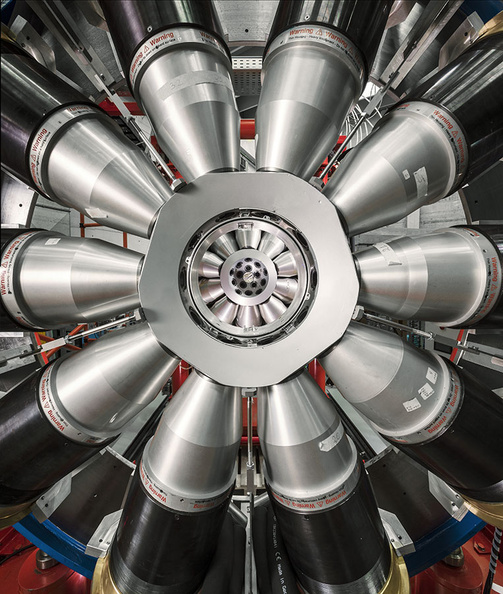
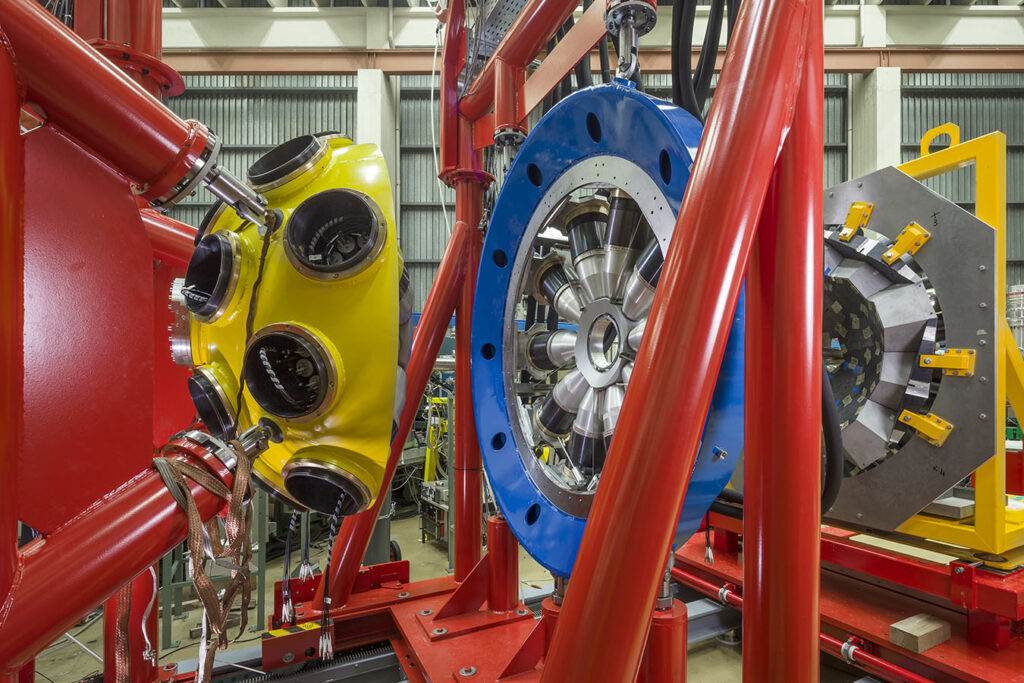
Previous Arrays
The group has a well-established expertise in nuclear spectroscopy with high-resolution gamma-arrays. Since the first experiments performed in the 90s, the group has hosted GASP, EUROBALL, CLARA, as well as the first stage of the last-generation European gamma-array, the AGATA demonstrator.
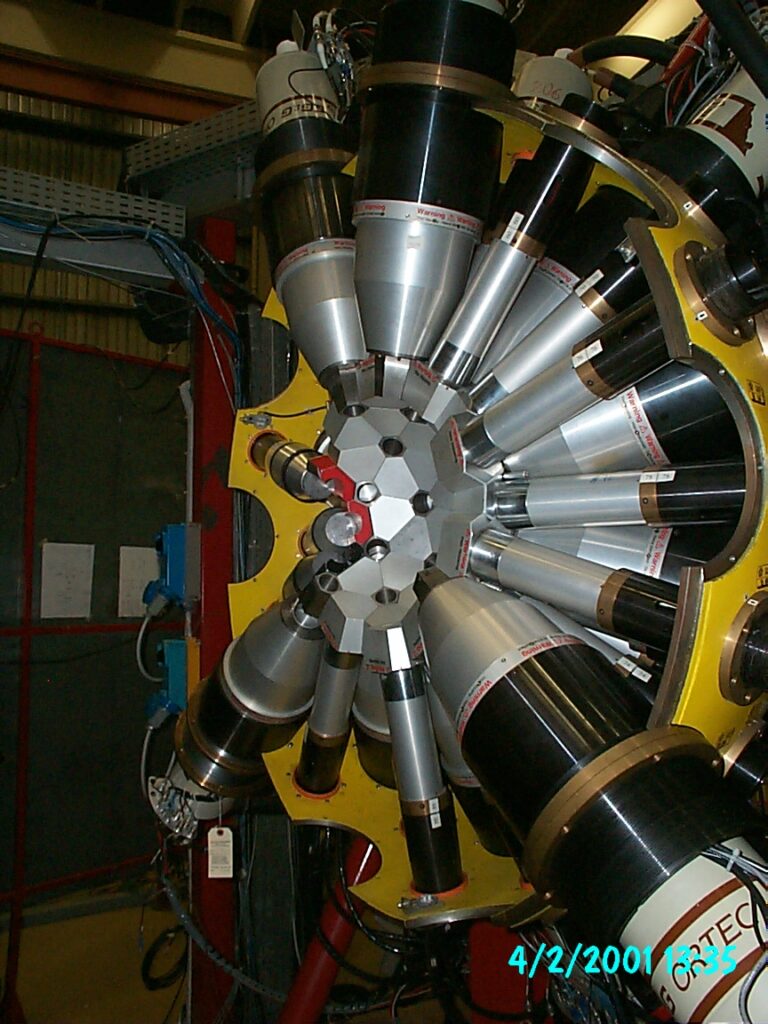

PRISMA
PRISMA is a large-acceptance magnetic spectrometer for heavy ions. Its design is based on a simple quadrupole-dipole configuration, with no hardware elements correcting for the optical aberrations, which are corrected instead via a software reconstruction of the trajectories of the nuclei inside the spectrometer. The trajectories are deduced from the point of entrance in the spectrometer and in the focal plane, where position-sensitive detectors are placed. The start detector of PRISMA is based on an MCP, while the focal plane detector is based on a MWPPAC. These detectors provide also a time-of-flight measurement. An ionisation chamber placed after the MWPPAC measures the charge and total energy of the incoming ions.

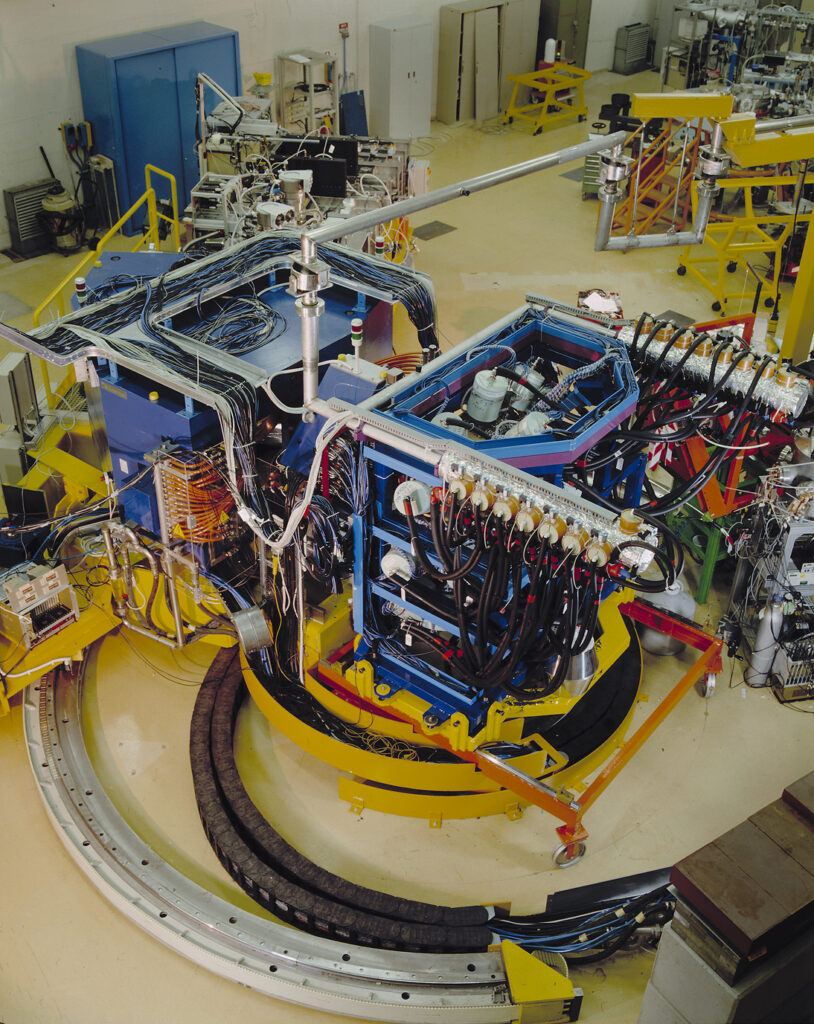
PLUNGER
A dedicated Plunger device for lifetime measurements using RDDS technique. Maximum distance of the plunger from the target is 1.2cm. Usage of”reversed plunger” was successfully tested.
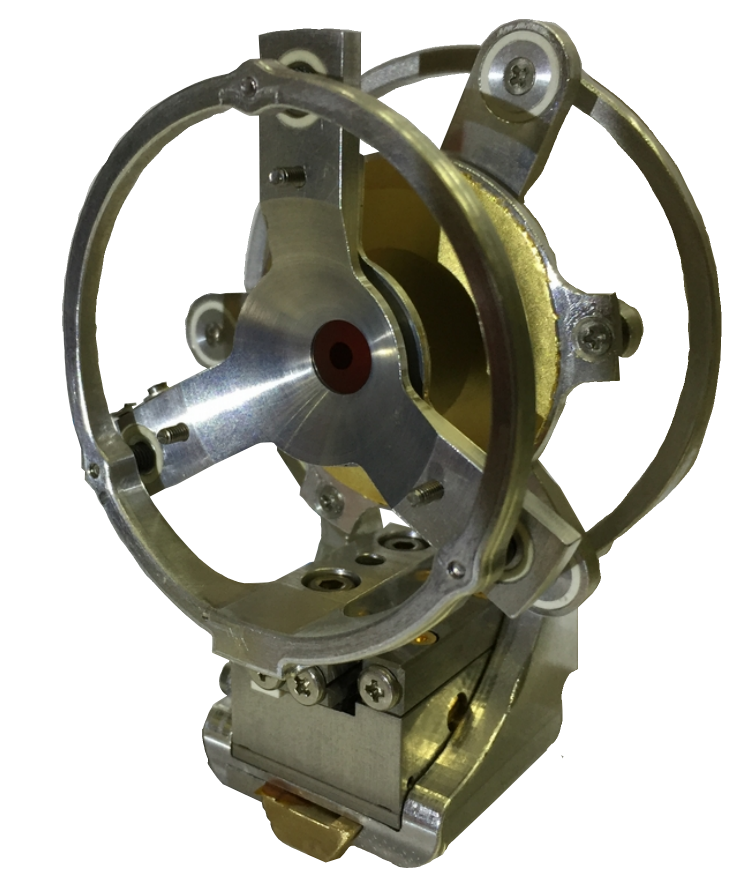
EUCLIDES
The EUCLIDES array is based on dE-E telescopes, the silicon thickness is 130 μm and 1000 μm for dE and E layers respectively. This allows the discrimination between light charged particles. 40 telescopes form a self-supported structure with the solid angle coverage close to 80% of 4π sr. Detector is made out of pentagonal and hexagonal detectors, the surface of each telescope is approximately 10cm2.
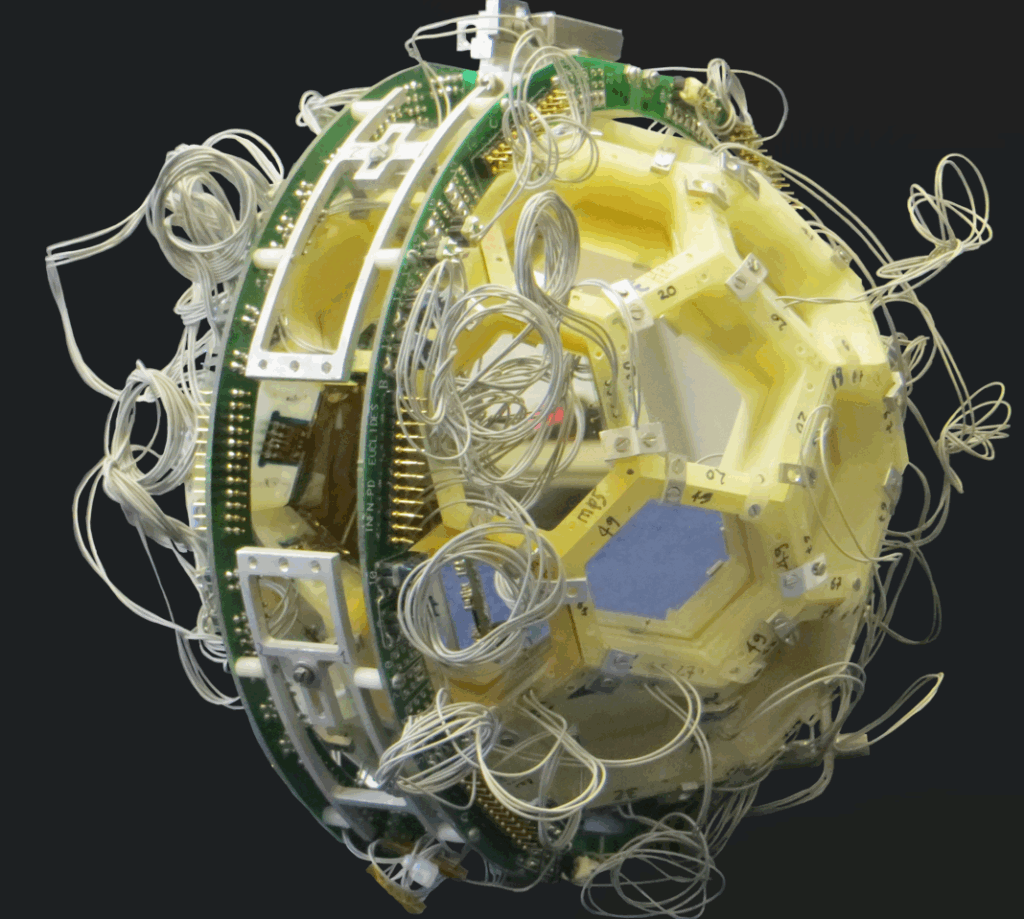
SPIDER
SPIDER is an array of segmented silicon detectors primarily made for heavy-ion detection in low-energy Coulomb-excitation experiments. The array is made out of 7 trapezoidal 300μm thick detectors, each composed of 8 strips. Angular coverage is 124-161° covers 17% of 4π. These values can be however adjusted by changing the distance of the array from the target.
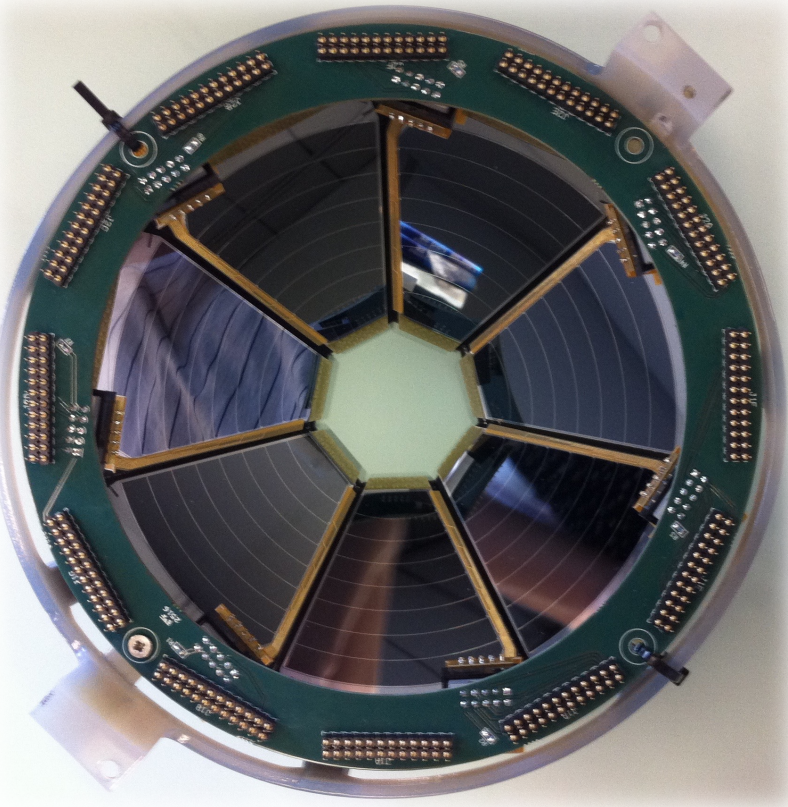
SAURON
SAURON is an annular double-sided silicon stripped ion detector for detection of light charged particles. Junction side is divided into 4 quadrants, each with 16 radial strips; ohmic side is divided into 16 azimuthal strips. Placing detector at standard 5cm distance from the target provides angular coverage of 25-44° if mounted forward, or 136-154° if mounted backward. The distance from the target may be adjusted. Available are 300, 500, 1000 and 1500 μm thick detectors.

DANTE
DANTE is a position-sensitive array of MCP detectors. Each MCP has, 40 x 60mm2 with position resolution below 1mm and time resolution of 130ps. Individual detectors are mounted on a ring in chevron configuration. Five support rings are available covering various &theta angles, from near-zero to 90°. Additional support for 2 DANTEs, covering θ from ~42 to ~78°, are available for use in conjunction with SPIDER.
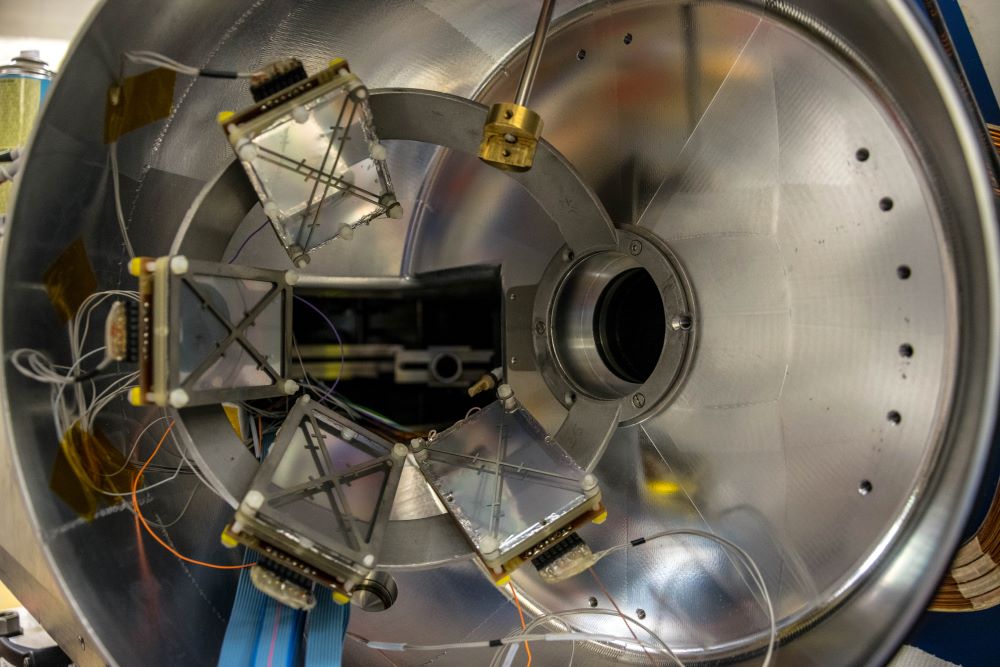
TRACE
TRACE is an array of highly-segmented silicon telescopes aimed at performing spectroscopy and discrimination of charged particles and light ions in transfer reactions. It is made out of 60 4x4mm square pads arranged in 12×5 configurations. The dE layer is 200μm thick while the E layer is 1-1.5mm thick.
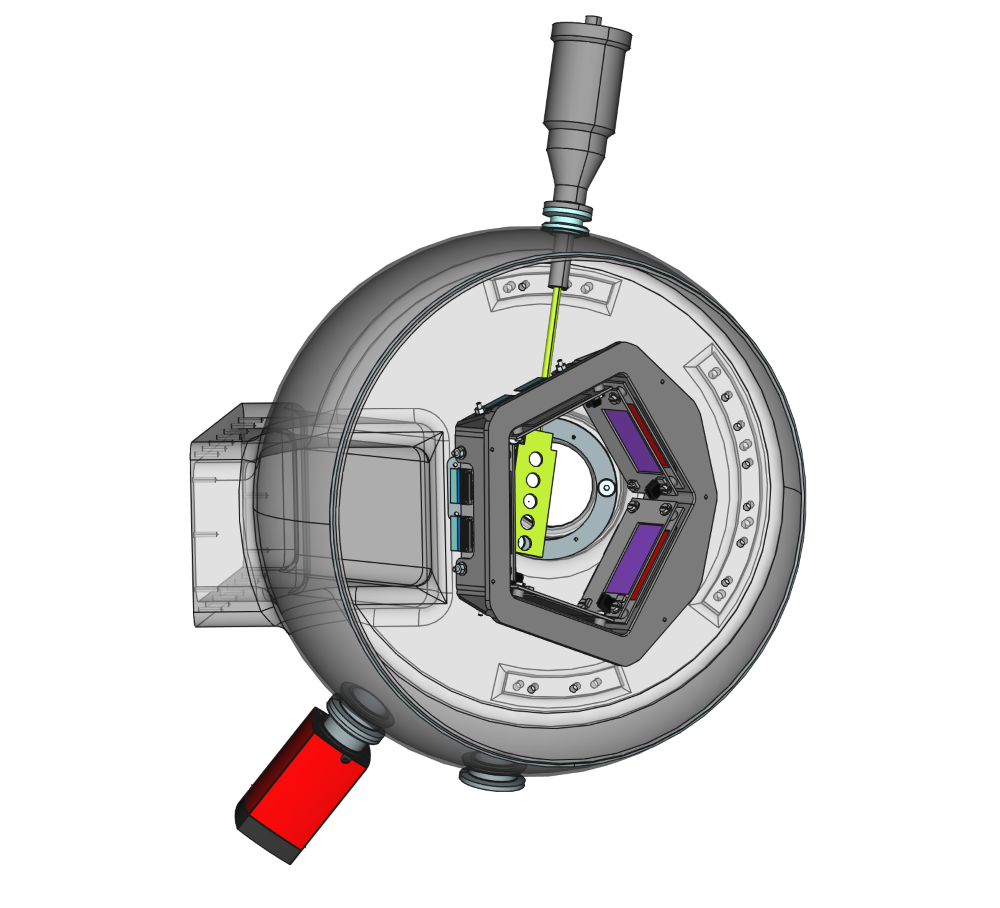
OSCAR
Oscar is an array of 128 δE-E pseudo-telescopes for identification of light charged particles. It is 2 arrays, each composed of 20μm thick silicon detector segmented into 16 strips, and a 16 500μm thick silicon pads arrange in 4×4 matrix.
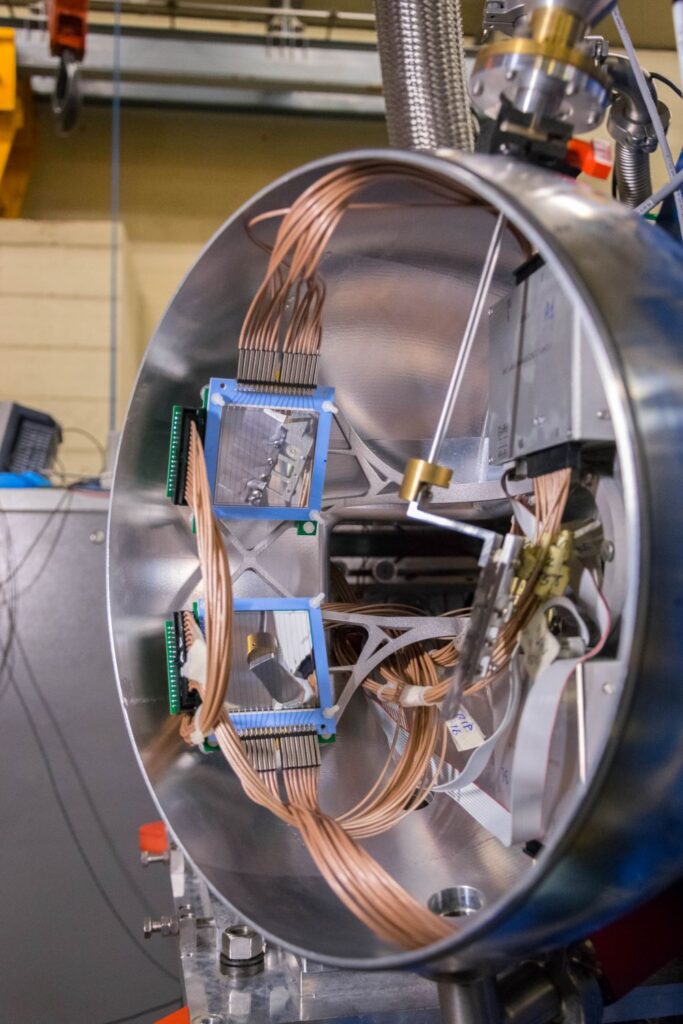
LaBr3
Array of LaBr3:Ce scintillators is couled with AGATA to provide fast timing measurements and high-energy γ-ray spectroscopy. Array consist of four 3″x3″ detectors and four 2″x2″ detectors.

NEDA
Neutron detector array.
NEUTRON WALL
The EUROBALL neutron wall.
RFD
The Recoil Filter Detector.
CTADIR
The goal of the Cryogenic Targets for DIrect Reactions (CTADIR) research project is the construction of cryogenic targets for the study of direct nuclear reactions with the exotic beams produced by the upcoming SPES facility at LNL. The CTADIR project has three research units: INFN-LNL, University of Padova and University of Milan. The INFN-LNL, in particular, is in charge of developing a cryogenic target for 3,4He, designed to be coupled to compact-geometry state-of-the-art detector arrays such as AGATA or GRIT. The cryogenic target has to be kept at temperatures below 10K in order to achieve the desired target density within a limited space of several millimetres.
The project is financed by the PRIN 2017 call for funding.
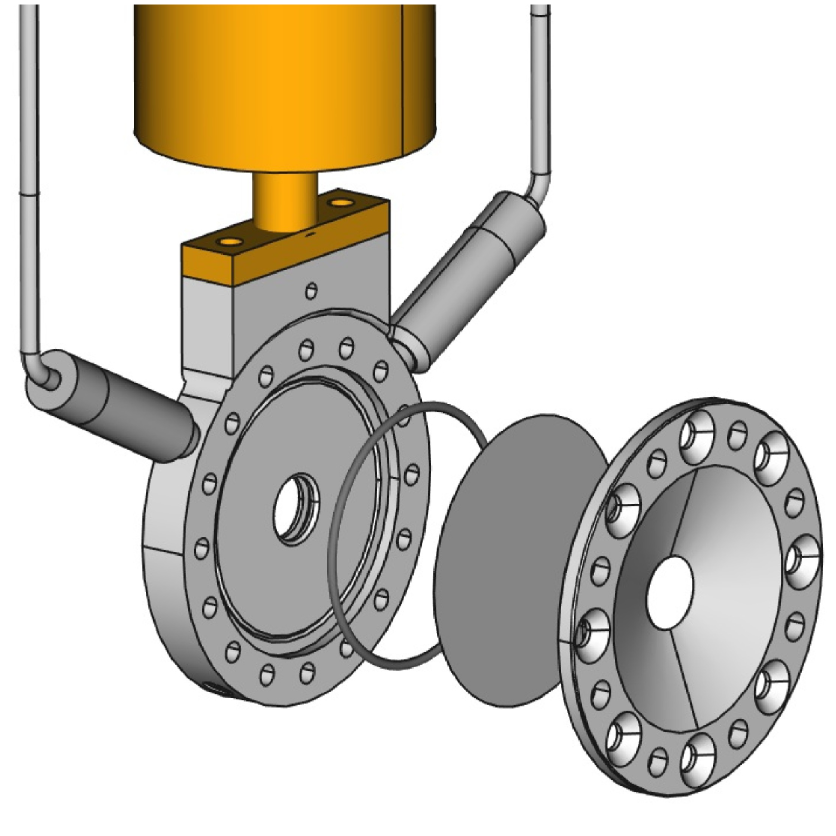
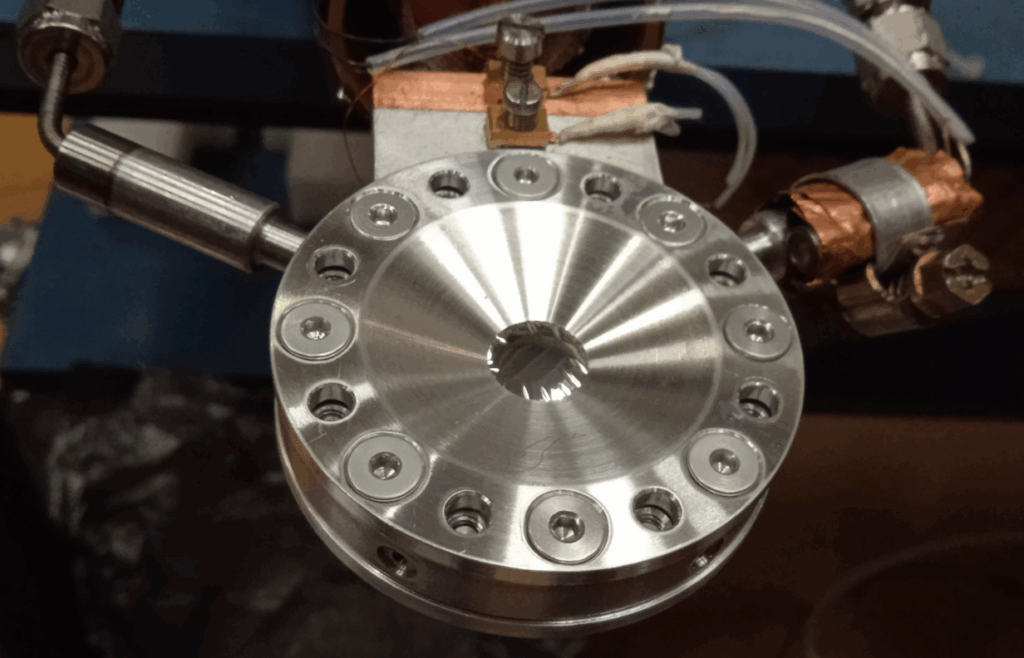
AGATA physics publications
December 2023 | High-Precision Spectroscopy of 20O Benchmarking Ab Initio Calculations in Light Nuclei | I. Zanon, E. Clément, A. Goasduff, et al.PRL 131, 262501 (2023)
August 2021 | Evidence for enhanced neutron-proton correlations from the level structure of the N=Z+1 nucleus 4387Tc44 | X. Liu, B. Cederwall, C. Qi, et al.Phys. Rev. C 104, L021302 (2021)
December 2019 | Lifetime measurements of N around 20 phosphorus isotopes using the AGATA gamma-ray tracking spectrometer | L. Grocutt, R. Chapman, M. Bouhelal, et al.Phys. Rev. C 100, 064308 (2019)
February 2018 | Quadrupole collectivity in 42Ca from low-energy Coulomb excitation with AGATA | K. Hadyńska-Klęk, P. Napiorkowski, M. Zielińska, et al.Phys. Rev. C 97, 024326 (2018)
October 2017 | Neutron effective single-particle energies above 78Ni: A hint from lifetime measurements in the N=51 isotones 85Se and 87Kr | F. Didierjean, D. Verney, G. Duch\^ene, et al.Phys. Rev. C 96, 044320 (2017)
December 2015 | Transition probabilities in neutron-rich 84,86Se | J. Litzinger, A. Blazhev, A. Dewald, et al.Phys. Rev. C 92, 064322 (2015)
GALILEO physics publications
October 2023 | Level scheme of 92Nb and observation of an oblate collective rotational band | Z. Ren, J. Lu, G. Dong, et al.Phys. Rev. C 108, 044301 (2023)
April 2023 | Level scheme study of 91Mo: Weak-coupling approximation in the N=50 region | Z. Huang, G. Zhang, C. Yuan, et al.Phys. Rev. C 107, 044309 (2023)
2023 | An alternative viewpoint on the nuclear structure towards 100Sn: Lifetime measurements in 105Sn | G. Pasqualato, A. Gottardo, D. Mengoni, et al.Physics Letters B 845, 138148 (2023)
August 2022 | Reinvestigation of the level structures of the N=49 isotones 89Zr and 91Mo | Z. Ren, J. Lu, G. Zhang, et al.Phys. Rev. C 106, 024323 (2022)
August 2021 | High-spin intruder states in the mirror nuclei 31S and 31P | D. Testov, A. Boso, S. Lenzi, et al.Phys. Rev. C 104, 024309 (2021)
April 2021 | Octupole correlations near 110Te | D. Testov, S. Bakes, J. Valiente-Dobón, et al.Phys. Rev. C 103, 044321 (2021)
April 2021 | Probing isospin mixing with the giant dipole resonance in the 60Zn compound nucleus | G. Gosta, A. Mentana, F. Camera, et al.Phys. Rev. C 103, L041302 (2021)
October 2020 | Pseudospin partner bands in 130Ba | S. Guo, C. Petrache, D. Mengoni, et al.Phys. Rev. C 102, 044320 (2020)
July 2020 | Shape coexistence in neutron-deficient 188Hg investigated via lifetime measurements | M. Siciliano, I. Zanon, A. Goasduff, et al.Phys. Rev. C 102, 014318 (2020)
April 2020 | New level scheme and shell model description of 212Rn C. Li, G. Zhang, C. Yuan, et al.Phys. Rev. C 101, 044313 (2020)
2020 | Evidence for pseudospin-chiral quartet bands in the presence of octupole correlations | S. Guo, C.M. Petrache, D. Mengoni, et al.Physics Letters B 807, 135572 (2020)
January 2019 | Identification of high-K rotation in 130Ba: Testing the consistency of electromagnetic observables | Y. Qiang, C. Petrache, S. Guo, et al.Phys. Rev. C 99, 014307 (2019)
2019 | Diversity of shapes and rotations in the γ-soft $^{130}Ba nucleus: First observation of a t-band in the A = 130 mass region | C.M. Petrache, P.M. Walker, S. Guo, et al.Physics Letters B 795, 241-247 (2019)
January 2018 | One-neutron stripping processes to excited states of 90Y* in the 89Y(6Li,5Li)90Y* reaction | G. Zhang, G. Zhang, S. Hu, et al.Phys. Rev. C 97, 014611 (2018)
Technical publications
2025 | CTADIR: A 3,4He Cryogenic TArget for DIrect Reactions at low energy | M. Sedlák, A. Gottardo, R. Pengo, et al.NIM A 1080, 170626 (2025)
2023 | Conceptual design of the AGATA 2π array at LNL | J.J. Valiente-Dobón, R. Menegazzo, A. Goasduff, et al. NIM A 1049, 168040 (2023)
2021 | The GALILEO γ-ray array at the Legnaro National Laboratories | A. Goasduff, D. Mengoni, F. Recchia, et al.NIM A 1015, 165753 (2021)
2020 | Lifetime measurements using a plunger device and the EUCLIDES Si array at the GALILEO γ-ray spectrometer | J. Bradbury, D. Testov, S. Bakes, et al.NIM A 979, 164345 (2020)
2020 | SPIDER: A Silicon PIe DEtectoR for low-energy Coulomb-excitation measurements | M. Rocchini, K. Hadyńska-Klęk, A. Nannini, et al.NIM A 971, 164030 (2020)
2019 | The 4π highly-efficient light-charged-particle detector EUCLIDES, installed at the GALILEO array for in-beam γ-ray spectroscopy | D. Testov, D. Mengoni, A. Goasduff, et al.Eur. Phys. J. A 55, 47 (2019)
2019 | NEDA-NEutron Detector Array | J.J. Valiente-Dobón, G. Jaworski, A. Goasduff, et al.NIM A 927, 81-86 (2019)
2019 | A new dedicated plunger device for the GALILEO γ-ray detector array | C. Müller-Gatermann, F. von Spee, A. Goasduff, et al.NIM A 920, 95-99 (2019)
2019 | Neutron detection and γ-ray suppression using artificial neural networks with the liquid scintillators BC-501A and BC-537 | P.-A. Söderström, G. Jaworski, J.J. Valiente Dobón, et al.NIM A 916, 238-245 (2019)
2019 | A powerful combination measurement for exploring the fusion reaction mechanisms induced by weakly bound nuclei | S.P. Hu, G.L. Zhang, G.X. Zhang, et al.NIM A 914, 64-68 (2019)
2018 | Selection of different reaction channels in 6Li induced fusion reaction by a powerful combination of a charged particle array and a high-resolution gamma spectrometer | G. Zhang, S. Hu, G. Zhang, et al.EPJ Web Conf. 178, 03009 (2018)
2018 | Towards the lowest-energy limit for light ions identification with silicon pixel-type detectors | N. Cieplicka-Oryńczak, D. Mengoni, M. Ciemala, et al.Eur. Phys. J. A 54, 209 (2018)
2018 | Pulse pile-up identification and reconstruction for liquid scintillator based neutron detectors | X.L. Luo, V. Modamio, J. Nyberg, et al.NIM A 897, 59-65 (2018)
June 2017 | First measurement with a new setup for low-energy Coulomb excitation studies at INFN LNL | M. Rocchini, K Hadyńska-Klek, A Nannini, et al.Physica Scripta 92, 074001 (2017)
2015 | Digital pulse-timing technique for the neutron detector array NEDA | V. Modamio, J.J. Valiente-Dobón, G. Jaworski, et al.NIM A 775, 71-76 (2015)
2014 | Test of digital neutron-gamma discrimination with four different photomultiplier tubes for the NEutron Detector Array (NEDA) | X.L. Luo, V. Modamio, J. Nyberg, et al.NIM A 767, 83-91 (2014)
2014 | Digital pulse-shape analysis with a TRACE early silicon prototype | D. Mengoni, J.A. Dueñas, M. Assié, et al.NIM A 764, 241-246 (2014)
2013 | Characterization of large volume 3.5″x8″ LaBr3:Ce detectors | A. Giaz, L. Pellegri, S. Riboldi, et al.NIM A 729, 910-921 (2013)
2012 | Monte Carlo simulation of a single detector unit for the neutron detector array NEDA | G. Jaworski, M. Palacz, J. Nyberg, et al.NIM A 673, 64-72 (2012)
2004 | Monte Carlo simulations of the Neutron Wall detector system | Joa Ljungvall, Marcin Palacz, Johan NybergNIM A 528, 741-762 (2004)
1999 | The EUROBALL neutron wall – design and performance tests of neutron detectors | Ö. Skeppstedt, H.A. Roth, L. Lindström, et al.NIM A 421, 531-541 (1999)
Open projects
The group offers different thesis projects for bachelor, master and PhD thesis.
Below you can find some of the possible topics for your thesis. Contact the corresponding supervisor if you are interested!
Master Thesis: A new tool for the search for electric dipole moments: study of octupole structures in the light U, Th and Pa isotopes via Multinucleon Transfer
Supervisor: Kseniia Rezynkina, Francesco Recchia
The student will be involved in the experiment aiming to study octupole collectivity in U, Th and Pa isotopes. We plan to do this in the LNL laboratory via a Multi-Nucleon Transfer reaction from a 232Th target, using the highly segmented gamma-ray tracking array AGATA and the electromagnetic spectrometer. These nuclei are good candidates for the studies of the Electric Dipole Moment (EDM) in the atomic nucleus, since they are predicted to have pear-shaped ground states. However, data for Th, Pa and U nuclei are incomplete and the theories give quite divergent predictions for some of the measurable observables. Main aim of this measurement is the determination of the low-lying structure of 226,228U (N=136) allowing, through the difference of the aligned angular momentum, a characterization of the octupole structure. The student will participate in the preparation of the experiment to be performed at Legnaro, in the data taking, and will take care of the first phase of the data analysis.
Master Thesis: Medical applications: Towards a new medical imaging modality, gamma-MRI, using long-lived polarised unstable tracers
Supervisor: Magda Kowalska (CERN), Francesco Recchia
This project is devoted to a new medical imaging modality that will use long-lived polarised Xe isomers inside a tailor-made low-field MRI magnet. Thanks to signal detection via changes in gamma-decay asymmetry, the approach can reach a billion times higher sensitivity than regular NMR and MRI. At CERN, we work on intense and pure Xe isomers samples to be sent to our colleagues in Geneva. The student will participate in preparing stable Xe samples for irradiation at reactors and for direct production of Xe isomers as a beam at the ISOLDE facility. He/she will help with setting up small experimental setups meant for extracting the samples from quartz vials or metallic foils and enclosing it in metallic transport containers. The student will also set up gamma detectors used to determine the Xe activity received from a nuclear reactor or produced at ISOLDE 1.
Master Thesis: Experimental study of the Nuclear Structure in the Island of Inversion
Supervisor: Pablo Aguilera, Francesco Recchia
The evolution of the shell structure around the island of inversion IoI is still a subject of debate. The particle-hole excitation plays a fundamental role in our understanding of the nuclear structure around the Island of Inversion (IoI). In the medium mass region at N=20 the 32Mg becomes the centre of the island of inversion, where the 0+ ground state exhibits an intruder configuration of 4p-4h excitations, and an excited 0+ state corresponding to the normal configuration predicted by the single particle shell model. This collective behaviour is the result of quadrupole correlations, favouring the intruder f7/2 and p3/2 orbitals. In order to understand the mechanisms that produce this phenomenon, it’s necessary to study the evolution of the collective behaviour in the neighbouring nuclei. The aim of this thesis will be to study the region around the IoI at N=20 via multi-nucleon transfer reaction and lifetime measurements in order to track intruder configurations in neighbouring nuclei.
A multi-nucleon transfer reaction will be performed in the Legnaro National Laboratory (LNL) using a 238U target and a 26Mg beam provided by the Piave-Alpi accelerator. The target will be surrounded by The Advanced GAmma Tracking Array (AGATA) coupled to the PRISMA magnetic separator. This configuration allows one to identify each fragment and perform lifetime measurements in the femto-second range with the Doppler Shift Attenuation Method (DSAM). The candidate will be able to participate in the experiment at the LNL and will analyse the data for the selected channels in collaboration with other research groups.
Defended thesis
2024 | In-beam spectroscopy study of fp shell nuclei: 63Zn and the proton unbound 55Cu | Sara Pigliapoco, Università degli Studi di Padova | Supervisore: Francesco Recchia
2024 | Mixing between single-particle and intruder configurations towards the N=20 Island of Inversion: lifetimes in 37S | Luca Zago, Università degli Studi di Padova | Relatori: Jose Javier Valiente Dobón, Andrea Gottardo, Franco Galtarossa
2023 | Excited state lifetimes in the fp – shell mirror nuclei | Rafael Escudeiro, Universidade de Sao Paulo, Università degli Studi di Padova | Supervisore: Nilberto Heder Medina, Francesco Recchia
2022 | Testing three-body forces in light nuclei: Lifetime measurements in 20O in the femtosecond range | Irene Zanon, Università degli Studi di Ferrara | Supervisori: Diego Bettoni, Alain Goasduff, Emmanuel Clément
2022 | Investigating the 46Ar proton wave function with the 46Ar(3He,d)47K direct reaction | Daniele Brugnara | Università degli Studi di Padova | Supervisori: Daniele Mengoni, Andrea Gottardo, José Javier Valiente Dobón
2020 | Lifetime measurements in 105Sn: the puzzle of B(E2) strengths in Sn isotopes | Giorgia Pasqualato, Università degli Studi di Padova | Relatori: Daniele Mengoni, Andrea Gottardo
2017 | Nuclear structure of the semi-magic tin isotopes close to 100Sn: lifetime measurements of low-lying states in 106Sn and 108Sn | Marco Siciliano, Università degli Studi di Padova | Supervisori: José Javier Valiente Dobón, Alain Goasduff
2015 | Study of shape evolution in the neutron-rich osmium isotopes with the advanced gamma-tracking array AGATA | Philipp Rudolf John, Università degli Studi di Padova | Supervisori: Daniele Mengoni, Santo Lunardi, José Javier Valiente Dobón
Master thesis
2024 | First production of the isospin T=3/2 nucleus 29S using the 3-neutron evaporation channel of the 20Ne+12C fusion reaction | Denise Lazzaretto, Università degli Studi di Padova | Relatore: Francesco Recchia, Correlatore: Kseniia Rezynkina
2023 | Characterization of silicon detectors for studies of deep sub-barrier heavy-ion fusion by coincidences with the AGATA gamma-spectrometer | Alex Cobo Zarzuelo, Università degli Studi di Padova | Relatore: Giovanna Montagnoli, Correlatore: José Antonio Dueñas Díaz, Alberto Stefanini,
2023 | Double-γ measurement and its implications on 0νββ decay: a feasibility study | Damiano Stramaccioni, Università degli Studi di Padova | Relatori: Jose Javier Valiente Dobón, Matúš Balogh,
2023 | Study of lifetimes of nuclear excited states near the N=20 island of inversion using the Doppler Shift Attenuation Method | Raquel Nicolás del Álamo, Università degli Studi di Padova | Relatori: Daniele Mengoni, Franco Galtarossa, Irene Zanon, Daniele Brugnara
2022 | Search for a Josephson-like effect in the 116Sn + 60Ni system | Giuseppe Andreetta, Università degli Studi di Padova | Relatore: Daniele Mengoni, Correlatore: Franco Galtarossa, Lorenzo Corradi
2022 | Commissioning of the AGATA gamma-ray tracking array | Filippo Angelini, Università degli Studi di Padova | Relatori: José Javier Valiente Dobón, Rosa María Pérez Vidal
2022 | In-beam commissioning of the AGATA-PRISMA setup at Legnaro National Laboratories | Elia Pilotto, Università degli Studi di Padova | Relatori: Daniele Mengoni, Franco Galtarossa
2022 | Characterisation of the SpecMAT active target for the α(86Kr, 3He)87Kr transfer reaction | Anita Candiello, Università degli Studi di Padova | Relatore: Francesco Recchia, Riccardo Raabe, Correlatore: Oleksii Poleshchuk, Andreas Ceulemans
2021 | Production of metastable Xenon isotopes for a new medical imaging modality, Gamma-MRI | Ilaria Michelon, Università degli Studi di Padova | Relatore: Francesco Recchia, Correlatore: Magda Kowalska
2020 | New measurement of the lifetime of the first 2+ state in 82Zr | Sara Carollo, Università degli Studi di Padova | Relatore: Francesco Recchia, Correlatore: Jeongsu Ha
2020 | Isomer decay spectroscopy of neutron-rich nuclei around A ∼ 210 | Luca Zago, Università degli Studi di Padova | Relatori: José Javier Valiente Dobón, Andrea Gottardo
2020 | Isospin symmetry in the fp-shell mirror nuclei | Sara Pigliapoco, Università degli Studi di Padova | Relatore: Francesco Recchia, Correlatore: Martha Liliana Cortés Sua
2018 | Commissioning Experiment of the AGATA+MUGAST+VAMOS Setup for Direct Reaction Studies | Andrea Raggio, Università degli Studi di Padova | Relatore: Daniele Mengoni, Correlatore: Marlene Assie
2018 | Study of Shape Coexistence in the 188Hg nucleus via lifetime measurements | Irene Zanon, Università degli Studi di Padova | Relatore: Alain Goasduff, Correlatore: Marco Siciliano
2018 Test of a 3He target to be used for transfer reactions in inverse kinematics and study of the nuclear structure of 74Se | Gabriele Carozzi, Università degli Studi di Padova | Relatori: Daniele Mengoni, Jose Javier Valiente Dobón, Marco Siciliano
2018 | Perspectives on the measurement of competitive double gamma decay with the AGATA tracking arrays | Daniele Brugnara, Università degli Studi di Padova | Relatore: Jose Javier Valiente Dobón, Correlatore: Alain Goasduff
2017 | Investigation of shape coexistence in 60Zn by using the γ-ray spectrometer GALILEO at the LNL | Giorgia Pasqualato, Università degli Studi di Padova | Relatore: Daniele Mengoni
2024 | Caratterizzazione di rivelatori a semiconduttore ad alta efficienza per lo studio di transizioni proibite in sistemi nucleari | Alberto Nati, Università degli Studi di Padova | Relatore: Daniele Mengoni, Correlatore: Daniele Brugnara
2023 | Caratterizzazione dei rivelatori al germanio di nuova generazione | Anna Togni, Università degli Studi di Padova | Relatore: Francesco Recchia, Correlatore: Rafael Escudeiro
2022 Octupole correlations in 110Xe | Damiano Stramaccioni, Università degli Studi di Padova | Relatori: Jose Javier Valiente Dobón, Rosa María Pérez Vidal, Andrés Illana Sisón
2022 | Misura di vita media di uno stato eccitato nel nucleo 61Zn | Giancarlo Zilli, Università degli Studi di Padova | Relatore: Francesco Recchia, Correlatore: Rafael Escudeiro
2021 | Studio della struttura nucleare dello 62Zn con tecniche di spettroscopia gamma | Edoardo Fiesoli, Università degli Studi di Padova | Relatore: Silvia Lenzi
2021 | Spettroscopia gamma di nuclei ricchi di protoni con lo spettormetro gamma AGATA | Emma Raniero, Università degli Studi di Padova | Relatore: Silvia Lenzi
2021 | Spettroscopia gamma di nuclei ricchi di protoni con lo spettormetro gamma AGATA | Gianmarco Esposto, Università degli Studi di Padova | Relatore: Silvia Lenzi
2021 | Studio della struttura di nuclei rotazionali della shell f7/2 con il modello a shell interattivo | Alberto Cattelan, Università degli Studi di Padova | Relatore: Silvia Lenzi
2020 Characterization of highly-segmented silicon detectors for direct reactions with radioactive beams | Riccardo Lombardi, Università degli Studi di Padova | Relatore: Daniele Mengoni, Correlatore: Alain Goasduff
2020 | Studi di struttura nucleare con lo spettrometro GALILEO | Matilde Avesani | Università degli Studi di Padova | Relatore: Silvia Lenzi, Correlatore: Dmitry Testov
2020 | Study of discrete symmetry in 21Ne | Edoardo Buonocore, Università degli Studi di Padova |Relatore: Daniele Mengoni, Correlatore: Lorenzo Fortunato
2020 | Metodi radioattivi per los tudio della struttura nucleare in nuclei pesanti | Matteo Gambrioli, Università degli Studi di Padova | Relatore: Silvia Lenzi
2020 | Probabilita di transizione nei nuclei speculari 49Mn e 49Cr | Mirko Menni, Università degli Studi di Padova | Relatore: Silvia Lenzi
2020 | Metodo sperimentale per studiare nuclei con alone | Silvia Ziviani | Università degli Studi di Padova | Relatore: Silvia Lenzi
2020 | Struttura a cluster in nuclei leggeri | Anna Vigolo, Università degli Studi di Padova | Relatore: Silvia Lenzi
2020 | Utilizzo di ioni pesanti nella terapia oncologica | Elisabetta Campedelli, Università degli Studi di Padova | Relatore: Silvia Lenzi
2020 | Eccitazione Coulombiana di fasci di ioni radioattivi ad energie intermedia | Pietro Miglioranza, Università degli Studi di Padova | Relatore: Silvia Lenzi
2020 | Study of low lying levels of 72Ni | Filippo Angelini, Università degli Studi di Padova | Relatore: Martha Liliana Cortés, José Javier Valiente Dobón
2019 | Nuclear Structure of 33S using the GALILEO γ-ray spectrometer | Anita Candiello, Università degli Studi di Padova | Relatore: Silvia Lenzi, Correlatore: Dmitry Testov
2019 | Lifetime measurements with fast-timing scintillators | Marta Magalini, Università degli Studi di Padova | Relatore: Daniele Mengoni, Correlatore: Andrés Illana Sisón, Alain Goasduff
2019 | Isospin Symmetry Breaking Effects on Mirror Nuclei 43Ti and 43Sc | Francesco Gentile | Università degli Studi di Padova | Relatore: Silvia Lenzi
2019 | Differenze di energia di eccitazione tra stati analoghi in nuclei speculari di massa A=30-40 | Martina Cottini, Università degli Studi di Padova | Relatore: Silvia Lenzi
2018 | Ottimizzazione di TRACE, un array di rivelatori segmentati di silicio, per lo studio di reazioni di trasferimento a LNL | Anna Braghetto, Università degli Studi di Padova | Relatore: Alain Goasduff, Correlatore: Marco Siciliano
2018 | Exploring the Pulse Shape Discrimination capabilities of the ΔE silicon detectors of the EUCLIDES array | Giovanni Sighinolfi, Università degli Studi di Padova | Relatore: Alain Goasduff, Correlatore: Marco Siciliano, Daniele Mengoni
2018 | Study heavy elements with exotic beams at ISOLDE (CERN) | Marco Bortolami, Università degli Studi di Padova | Relatore: Jose Javier Valiente Dobón, Correlatore: Andrés Illana Sisón
2017 | Characterization with digital electronics of a neutron detector for fast neutrons | Andrea Raggio, Università degli Studi di Padova | Relatori: G. Jaworski, V. Modamio, J.J. Valiente-Dobón, D. Mengoni
2016 | Studio della struttura dei nuclei 24Mg e 26Mg mediante spettroscopia gamma | Mirco Del Fabbro, Università degli Studi di Padova | Relatore: Francesco Recchia, Correlatore: Alberto Boso
Visiting LNL
- If you are planning to come to LNL for experiments or collaboration, you first need to register as LNL user. You can find procedure here
- If you would like to book the LNL- Guesthouse, follow this procedure
- You might also want to check:
- Get to Venice Marco Polo airport
- Reach Padova by train with Trenitalia, or get apps Google Play Apple Store
- Get from Padova to Legnaro with Busitalia, or get apps Google Play Apple Store
People
The group if INFN-LNL works in close collaboration with the group of the University of Padova and INFN-Padova.
STAFF: Alain Goasduff, Andrea Gottardo, Daniele Mengoni, Francesco Recchia, Franco Galtarossa, Giacomo De Angelis, Roberto Menegazzo, Silvia Lenzi, Walter Raniero
POSTDOCS: Beau Graves, Benito Gongora Servin, Eleanor Ronning, Elia Pilotto, Fanfei Zeng, Jaime Benito, Julgen Pellumaj, Kseniia Rezynkina, Matus Balogh, Sara Carollo
PhD STUDENTS: Anna Togni, Damiano Stramaccioni, Federico SImioni, Giuseppe Andreetta, Raquel Nicolas Del Alamo, Simone Rocca
FORMER MEMBERS: Aysegul Ertoprak, Dainel Napoli, Daniele Brugnara, Eleonara Gregor, Filippo Angelini, Giorgia Pasqualato, Guangxin Zhang, Jeongsu Ha, Irene Zanon, Josè Javier Dobon Valiente, Javier Collado, Marta Polettini, Luca Zago, Marco Siciliano, Pablo Aguilera Jorquera, Martha Liliana Cortes, Rosa Maria Perez Vidal, Matus Sedlak, Sara Pigliapoco, Zhen Huang, Rafael Escudeiro
Useful links
- Get an overview of the LNL accelerators and the different experimental setups
- Take a look at the beam time schedule
- Become part of the community by registering to the LNL Users Group
- Interested in proposing an experiment with GALILEO or AGATA?
- Check the LNL PAC and the current call for proposals
- Take a look at the possible TAP beams
- Contact a staff member of the group to further discuss your ideas!
- Look at the current job opportunities offered by INFN or check the possible bachelor, master, and PhD thesis offered by the group
- Check the “Galileo Galilei” physics department of the University of Padova
- Take a look at some of the official websites from different INFN sections:
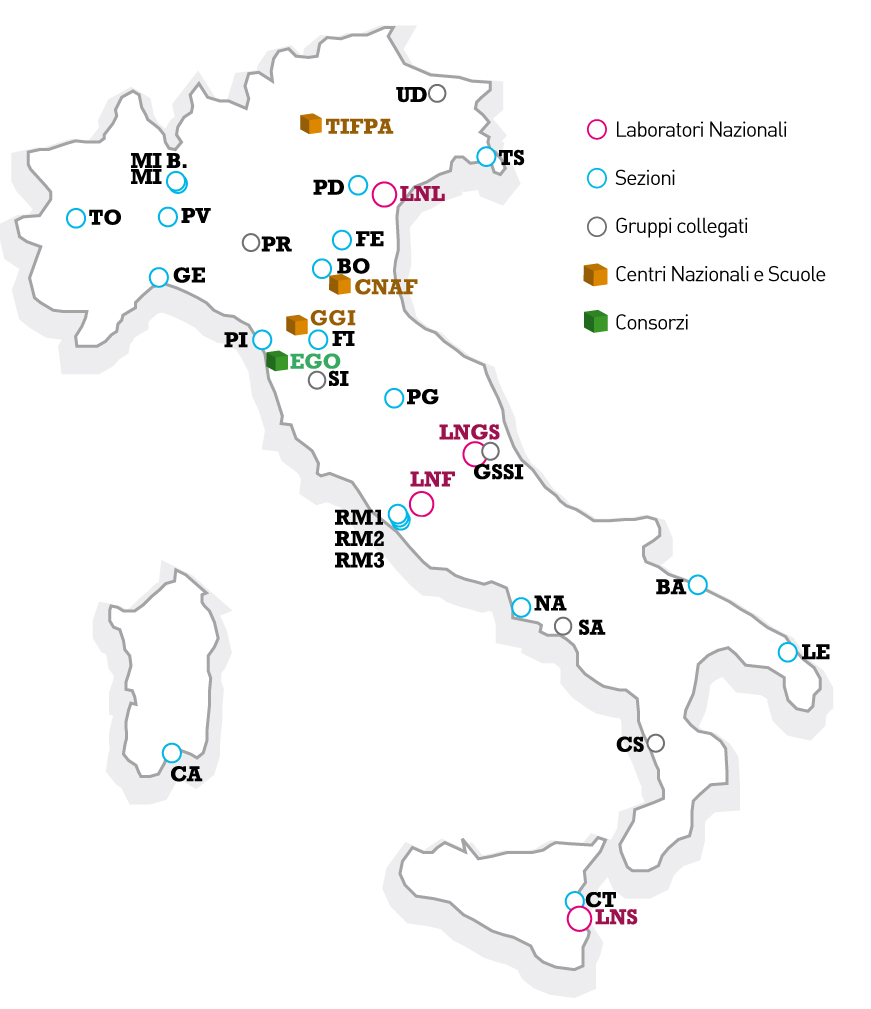
- INFN – Laboratori Nazionali di Legnaro (LNL)
- INFN – Laboratori Nazionali del Sud (LNS)
- INFN – Laboratori Nazionali di Frascati (LNF)
- INFN – Laboratori Nazionali del Gran Sasso (LNGS)
- INFN – Sezione di Firenze (FI)
- INFN – Sezione di Genova (GE)
- INFN – Sezione di Milano (MI)
- INFN – Sezione di Napoli (NA)
- INFN – Sezione di Padova (PD)
- Check for the call for proposals of other laboratories:
Here you can find a list of tools and resources from INFN-LNL. Most of them require you to login with your INFN-AAI credentials
- To register computers and solve IT issues, go to IT service of LNL
- Document server Alfresco
- Repository Baltig
- File sender
- Pandora
- Cloud Veneto
- The GALILEO wiki
- The L. Vannucci library of LNL
PISOLO Heavy-Ion Reactions near the Coulomb barrier – Sub-barrier Fusion
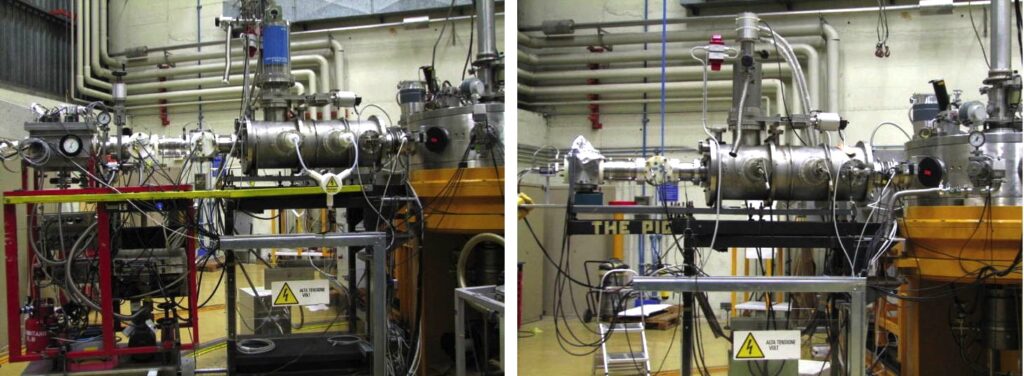
List of all fusion cross sections that we measured, starting from 1984, using the XTU Tandem
accelerator beams and the set-up based on the electrostatic deflector
List of publication from 1997
List of reports from 1998 to 2021
Relevant articles
- PRISMA – a magnetic spectrometer for heavy ions at LNL (Moscow 2003)
- The heavy-ion magnetic spectrometer PRISMA (Divonne 2000)
- Fusion-evaporation cross sections for 48Ca + 154Sm near the Coulomb barrier
- Excitation functions for 208–211Fr produced in the 18O +197Au fusion reaction
- Multinucleon transfer processes in 40Ca +208Pb
- Fusion of 48 Ca + 90,96 Zr above and below the Coulomb barrier
- The large-area micro-channel plate entrance detector of the heavy-ion magnetic spectrometer PRISMA
- The focal plane detector of the magnetic spectrometer PRISMA
- Response function of the magnetic spectrometer PRISMA
Useful links